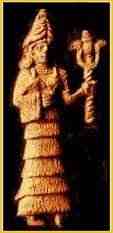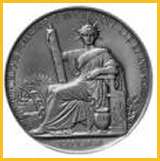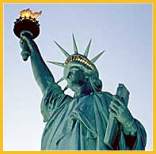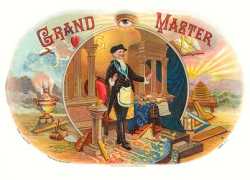Freemasonry
The cult of liberty in the eighteenth century is intimately associated with Freemasonry. The political and social goal of Freemasonry was and still is to "free" man from the "tyranny" of the Catholic Church and from any civil authority which does not claim to be democratic. By definition, a church or a regime is tyrannical for the Freemason if it seeks to make dogmas or to rule without the consent of the governed.
For this reason Freemasons have always detested the Roman Catholic church, since she claims power from heaven to teach supernatural doctrines and make binding laws, all of which must be adhered to by the whole of humanity. Freemasons have similarly opposed any monarchy which did not divest itself of power [like the present British monarchy, its powerlessness]. Therefore any monarch who would not cave in to their demands for socialistic democracies, where power was considered to come from the people and not from God, met with the solemn disapproval of Freemasonry. Starting with the execution of Louis XVI in 1793, they have not ceased to labor against the monarchies of Europe and elsewhere which did not conform themselves to their principles. One by one did these monarchies come down during the nineteenth century, until finally, by the end of World War I, the Austrian Emperor, the Russian Czar, and the German Kaiser collapsed as heads of state, yielding to, as always, liberal, socialistic democracies, with a curious preponderance of Jews in the government.
The motive for fighting World War I, at least according to the Allied propaganda of the time, was to "free" the world from "Czardom" and "Kaiserdom." Wilson said that the reason why we had to enter the war against Germany was in order to "make the world safe for democracy."
One should not infer, however, from these comments that the regimes of the monarchies of nineteenth and early twentieth century Europe were by any means perfect. The Austrian Emperor, the Czar, and the Kaiser had all given the Church considerable difficulty, but certainly no more difficulty than the liberal, socialistic democracies of France and England. Italy too had persecuted the Church, and although then a monarchy like England, was nevertheless virtually democratic, its monarch very much in the hands of the Freemasons and other similar anti-catholic secret societies. It is merely to point out that Freemasonry has a hatred for any power, ecclesiastical or civil, which claims its authority from God, and which is not somehow dependent upon the people for its power.
Freemasonry seeks to "free" people politically and socially from such "bonds," so that they might enjoy the "liberty" of a democratic regime.
This hatred of Freemasonry for the papacy and for monarchy can be seen in the initiation rites of the Knight Kadosh [thirtieth degree], in which the Knight is called upon to run the sword through two skulls, one bearing the papal tiara and the other the crown. The symbolism of such an act needs no comment whatsoever.
The cult of liberty has always been a favorite of the Freemasons. The liberty they seek is not the legitimate and due liberty from the burdensome constraints of socialistic governments, which a citizen may rightfully desire, but rather freedom from the authority of God, the "freedom" of the devil, the liberty of perdition, as Saint Augustine called it. They desire not the liberty of the sons of God, but the "liberty" which makes us slaves to sin.
The Statue of Liberty—A Masonic Goddess from Top to Bottom
The Babylonian Ishtar, Imperial Rome's goddess Libertas was Papal Rome's "MOTHER OF THE HARLOTS AND ABOMINATIONS OF THE EARTH" and the template for America's Statue of Liberty.
One of the many proofs of Freemasonry's cult of liberty, and furthermore of its deep influence upon our culture and mentality, is the Statue of Liberty. This colossus in New York's harbor was conceived by Freemasons, financed by Freemasons, built by Freemasons, and installed by Freemasons in a Freemasonic ceremony. The poem about "the huddled masses" inscribed on its base was written by American Jewess, Emma Lazarus.
The maker of the statue was Freemason Frederic-Auguste Bartholdi. He had already made a statue of the Freemason Marquis de Lafayette for the city of New York, for the occasion of the centenary of the signing of the Declaration of Independence.
Bartholdi sailed to America, at the suggestion of other Freemasons and kindred spirits in France, for the purpose of proposing the project. Although he had no drawings as he set sail, his Masonic biographer writes, as he entered New York harbor, "he caught a vision of a magnificent goddess (Nimrod's Semiramis—Isis or Astarte), holding aloft a torch (of Illuminism) in one hand and welcoming all visitors to the land of freedom and opportunity" (signifying Brotherhood control of the American people by the "liberties" perpetrated against them).
Returning to France, he managed to raise, through the help of a great deal of Masonic propaganda, the sum of 3,500,000 French francs, a very large sum for the 1870's. For the face of his "Goddess of Liberty" he chose his own mother.
Structural framework was provided by Freemason Gustave Eiffel, later to be famous for the 984-feet (300-meter) high Eiffel Tower. Although financial support for the statue was forthcoming in France, America was not willing to put up the money for the pedestal. It was Joseph Pulitzer, the owner and editor of the New York World, who managed to raise over $100,000 for the project.
On Washington's Birthday in 1877, Congress accepted the statue as a gift from the French people. Bedloe's Island, now Liberty Island, was chosen by General Sherman, the well-known Atlanta-burner. Meanwhile in Paris the work gradually progressed. Levi P. Morton, the then Ambassador to France, drove the first rivet. The statue was finished on May 21, 1884, and presented to Ambassador Levi Morton on July 4th of the same year by Ferdinand de Lesseps, builder of the Suez canal.
On the American side, the chairman of the American committee to receive the statue contacted the Grand Lodge of the Free and Accepted Masons of the State of New York. It had been a tradition in America to have the cornerstone of major public and private buildings and monuments "consecrated" with full Masonic rites, ever since Freemason George Washington, in 1793, had personally laid the cornerstone of the Capitol, with the assistance of the Grand Lodge of Maryland.
The cornerstone of the Washington Monument, inscribed "Joseph Pulitzer, Russian immigrant and Jew." was also laid in a Masonic ceremony. The ceremony was set for August 5, 1884. It poured rain.
The decorated vessel 'Bay Ridge' carried about a hundred Freemasons, along with some civil officials, to Bedloe's Island. Freemason Richard M. Hunt, the principal architect of the pedestal, handed the working tools to the Masonic officers.
Then Freemason Edward M.,L. Ehlers, Grand Secretary and a member of the Continental Lodge 287, read the list of items to be included in the copper box within the cornerstone: a copy of the United States Constitution; George Washington's Farewell Address; twenty bronze medals of Presidents up through Chester A. Arthur [including Washington, Monroe, Jackson, Polk, Buchanan, Johnson and Garfield, who were all Freemasons]; copies of New York City newspapers; a portrait of Bartholdi; a copy of 'Poem on Liberty' by E. R. Johnes; and a list on parchment of the Grand Lodge officers.
The traditional Masonic ceremony was observed. The cornerstone being found square, level and plumb, the Grand Master applied the mortar and had the stone lowered into place. He then struck the stone three times, and declared it duly laid. Then the elements of "consecration" were presented, corn, wine, and oil.
The "Most Worshipful" Grand Master then spoke a few words. He posed the question: "Why call upon the Masonic Fraternity to lay the cornerstone of such a structure as is here to be erected?"
His answer was: "No institution has done more to promote liberty and to free men from the trammels and chains of ignorance and tyranny than has Freemasonry."
The principal address was given by the Deputy Grand Master: "Massive as this statue is, its physical proportions sink into comparative obscurity when contrasted with the nobility of its concept. Liberty Enlightening the World! How lofty the thought! To be free, is the first, the noblest aspiration of the human breast. And it is now a univally admitted truth that only in proportion as men become possessed of liberty, do they become civilized, enlightened and useful."
The statue arrived in dismantled pieces in June of 1885. The statue was dedicated on October 28, 1886. President Grover Cleveland [who although sympathetically disposed toward the craft was not a Freemason] presided over the ceremony and Freemason Henry Potter, Episcopal Bishop of New York gave the invocation. Freemason Bartholdi pulled the tricolor French flag off the statue's face. The main address was given by Freemason Chauncey M. Depew, a United States Senator. mason7.htm
http://www.



